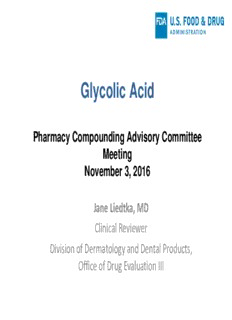
FDA Presentations for the November 3, 2016 Meeting of the Pharmacy Compounding Advisory ... PDF
Preview FDA Presentations for the November 3, 2016 Meeting of the Pharmacy Compounding Advisory ...
Glycolic Acid Pharmacy Compounding Advisory Committee Meeting November 3, 2016 Jane Liedtka, MD Clinical Reviewer Division of Dermatology and Dental Products, Office of Drug Evaluation III Glycolic Acid Review Team Jane Liedtka, MD, Clinical Reviewer, DDDP, ODE3 Ben Zhang, PhD, Chemistry Reviewer, OPQ Jianyong Wang, PhD, Pharmacology/Toxicology Reviewer, DDDP, ODE3 Doanh Tran, PhD., Clinical Pharmacology Team Leader, DCP3, OCP www.fda.gov 2 Nomination • Glycolic acid, 0.08% to 70%, has been nominated for inclusion on the list of bulk drug substances for use in compounding under section 503A of the Federal Food, Drug, and Cosmetic Act (FD&C Act) for topical use in the treatment of hyperpigmentation disorders and photodamaged skin www.fda.gov 3 Background • Glycolic acid is currently available in cosmetic formulations (creams, pads, and lotions) and present as excipient in some topical drug products www.fda.gov 4 Regulatory Definitions: Drugs and Cosmetics • Whether a product is a cosmetic or a drug under the law is determined by a product's intended use; different laws and regulations apply to each type of product • A drug is an article intended for use in the diagnosis, cure, mitigation, treatment, or prevention of disease or an article (other than food) that is intended to affect the structure or function of the body • A cosmetic is an article (other than soap) intended to be rubbed, poured, sprinkled, or sprayed on, introduced into, or otherwise applied to the human body for cleansing, beautifying, promoting attractiveness, or altering appearance – Regulated by CFSAN – No premarket approval of products or ingredients (except color additives) www.fda.gov 5 Cosmetic and Drug Uses of Topical Acids • Topical Acids cause exfoliation, or shedding of the skin surface. – The extent of exfoliation depends on the type and concentration of topical acid, its pH, and the other ingredients in the product – Examples of topical acids include glycolic, lactic, citric, kojic, and trichloroacetic acid • Examples of intended use of acids in cosmetics – “Smoothing fine lines” – “Improving skin texture and tone” • Examples of intended use of acids in drugs – “Hyperpigmentation disorder” or “melasma” – “Warts” or “genital warts” www.f da.gov 6 Physical and Chemical Characterization • Small organic molecule O HO • Highly soluble in water OH • Easily characterized with various analytical techniques • No stability issues reported for glycolic acid in the literature • Likely to be stable under ordinary storage conditions in the proposed dosage forms, such as lotions and gels www.fda.gov 7 Physical and Chemical Characterization (2) • Various synthetic routes to prepare glycolic acid • Likely impurities include: – Formaldehyde, monochloroacetic acid (starting materials) – Residual reagents – Sodium chloride, formic acid, methoxyacetic acid (byproducts from the synthesis process) • When potential impurities listed above are controlled, the physical and chemical characteristics do not raise significant safety concerns www.fda.gov 8 Physical and Chemical Characterization (3) • Summary – Based on the available information, there are no concerns about the physical and chemical characterization when potential impurities, such as formaldehyde, are controlled at acceptable levels: • well-characterized small molecule • Likely to be stable under ordinary storage conditions www.fda.gov 9 Pharmacology and Toxicology • Pharmacology – One theory for the mechanism of action of alpha- hydroxy acids (AHAs) in exfoliation is: AHAs reduce calcium ion concentration in the epidermis and remove calcium ions from the cell adhesions by chelation; this causes disruption in cell adhesions, and results in desquamation – Glycolic acid can suppress melanin formation by inhibition of tyrosinase activity www.fda.gov 10
Description: